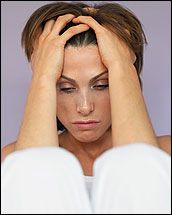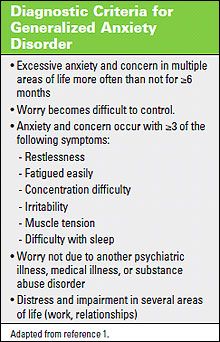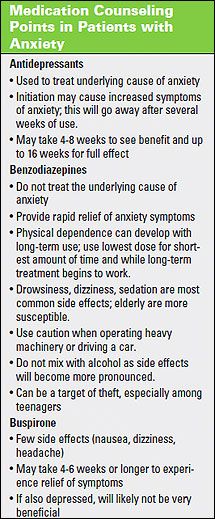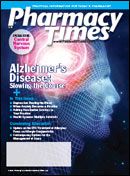Publication
Article
Pharmacy Times
When Anxiety Becomes a Disorder
Author(s):
This article provides medication-specific patients experiencing generalized anxiety disorder.
Dr. Vande Griend is an assistant professor in the Department of Clinical Pharmacy at the University of Colorado Denver School of Pharmacy, Aurora, Colorado.

Anxiety is the body?s naturalresponse to real or perceiveddanger. When kept in check,anxiety can be very useful by allowingindividuals to enhance their perceptionof external stimuli and potentiallyimprove performance. For example,anxiety from fear of failure may forcea pharmacy student to increase theamount of time spent studying andmay improve his or her mental acuity,resulting in better grades and retentionof knowledge. Likewise, anxietyconcerning inaccurately dispensing aprescription may result in a pharmacistdouble-checking his or her workor setting up safeguards within thepharmacy to prevent filling errors.
The natural response of anxiety becomesa disorder when it is excessiveand difficult to control and when it leadsto significant distress and impairment.For instance, excessive anxiety overan upcoming examination may cause apharmacy student physical symptoms(eg, abdominal pain, diarrhea, nausea)and prevent the student from being ableto focus on studying the material, resultingin poor performance.
Types of Anxiety

Table 1
Anxiety disorders come in 5 forms:social anxiety disorder, an irrationalpersistent fear of being negatively evaluatedand embarrassed by peers1,2; posttraumaticstress disorder, characterizedby exposure to a traumatic event,resulting in flashbacks and avoidance ofevent remembrance1,3; panic disorder,characterized by spontaneous attacksinvolving intense fear, with physicalsymptoms (eg, palpitations, sweating,and shortness of breath); obsessive?compulsive disorder, resulting in recurrentand persistent intrusive thoughtscausing fear and anxiety that lead toobsessions which can include repetitive behaviors (eg, cleaning, washing,counting)1,4; and generalized anxiety disorder(GAD), characterized by excessiveanxiety and worry that is not necessarilyspecific to any one concern.1,5
Treatment of anxiety varies, dependingupon the specific type of disorder,but generally includes both pharmacologicand nonpharmacologic approaches.According to a recent review, thepoint prevalence of GAD is 8% in primarycare, suggesting that GAD is themost common anxiety disorder seen byphysicians in this setting.6,7 In addition,medication therapy is the primary methodfor treating this disorder in the outpatientsetting. Full diagnostic criteria forGAD, adapted from the Diagnostic andStatistical Manual of Mental Disorders,are listed in Table 1.
Pharmacologic Treatments
The pharmacologic treatment of GADinvolves the use of antidepressants, benzodiazepines,and buspirone. Dependingon the severity of the anxiety, as well asthe response to individual medications,a patient may receive 1 or more of thesetreatment options.
Antidepressants
Antidepressants include selective serotoninreuptake inhibitors (SSRIs; eg, paroxetine,escitalopram, citalopram, fluoxetine,sertraline), serotonin and norepinephrinereuptake inhibitors (SNRIs; eg,venlafaxine, duloxetine), and tricyclicantidepressants (eg, amitriptyline, nortriptyline,imipramine). Antidepressantsare first-line treatment for GAD, becausethey treat the underlying cause, whichmay be an abnormality in serotonin.5,8,9SSRIs or SNRIs are considered equallyeffective.7 Choice of therapy is dependentupon cost and tolerability. Becauseof their side-effect profile, tricyclic antidepressantsare rarely used.
When initiating an antidepressant, itis important to start at a low dose andincrease the dose as necessary. Uponinitiation, side effects of antidepressantsinclude restlessness, jitteriness, insomnia,and agitation. These symptoms mimicanxiety, and may cause a patient to discontinue therapy. Patients shouldexpect at least 4 weeks before someimprovement has been seen and up to 16weeks for full effect.5
Benzodiazepines
Commonly used benzodiazepines includealprazolam (short half-life and durationof action), lorazepam and clonazepam(intermediate half-life and durationof action), and diazepam (long half-lifeand duration of action). Benzodiazepinesrapidly relieve the symptoms of anxiety,and are also useful for intermittent andepisodic flares in anxiety symptoms.They are not appropriate for use as firstlineor monotherapy treatment of GAD,because they do not treat the underlyingcause of the anxiety, but rather onlymask the symptoms. They are best used for acute relief of anxiety symptomswhile a long-term treatment is initiatedand begins to provide relief. In addition,benzodiazepines have many side effects,some of which are associated with longtermtreatment.9

Table 2
Buspirone
Buspirone is indicated for the treatmentof GAD, but not other anxiety disorders.It does not have activity against depression,a common comorbid condition associatedwith anxiety; therefore, it isnot considered first-line treatment.5,9 Itdoes not cause sedation, physical dependency,and has not been shown to leadto withdrawal, however.5 Because ofthis, it may have benefits over benzodiazepinesand possibly over antidepressants.Similar to antidepressants, it maytake 4 to 6 weeks or longer for benefit tobe realized; treatment of acute anxietysymptoms is likely needed when usingbuspirone for initial treatment.5
Importance of Counseling
The use of benzodiazepines will makea patient feel very relaxed, and anxietysymptoms will disappear very quickly.Because of this, it can be easy forpatients to overuse them and possiblydevelop side effects and addictive behaviorsover time. Educating patients aboutappropriate use may prevent long-termproblems. In addition, patients must beaware that antidepressants can causeincreased anxiety when first initiated.Patients discontinue therapy too frequentlydue to lack of knowledge concerningside effects and therapy expectations.Important medication-specificcounseling points for patients with anxietyare described in Table 2.
References
- American Psychiatric Association. Diagnostic and Statistical Manual of Mental Disorders DSM-IV-TR. Washington DC: American Psychiatric Association; 2000.
- Schneier FR. Clinical practice. Social anxiety disorder. N Engl J Med. 2006;355(10):1029-1036.
- Yehuda R. Post-traumatic stress disorder. N Engl J Med. 2002;346(2):108-114.
- Hoffman EJ, Mathew SJ. Anxiety disorders: a comprehensive review of pharmacotherapies. Mt Sinai J Med. 2008;75(3):248-262.
- Fricchione G. Clinical practice. Generalized anxiety disorder. N Engl J Med. 2004;351(7):675-682.
- Wittchen HU, Hoyer J. Generalized anxiety disorder: nature and course. J Clin Psychiatry. 2001;62(Suppl 11):15-19; discussion 20-21.
- Shearer SL. Recent advances in the understanding and treatment of anxiety disorders. Prim Care. 2007;34(3):475-504, v-vi.
- Brawman-Mintzer O, Lydiard RB. Biological basis of generalized anxiety disorder. J Clin Psychiatry. 1997;58(Suppl 3):16-25; discussion 6.
- Ballenger JC, Davidson JR, Lecrubier Y, et al. Consensus statement on generalized anxiety disorder from the International Consensus Group on Depression and Anxiety. J Clin Psychiatry. 2001;62(Suppl 11):53-58.







